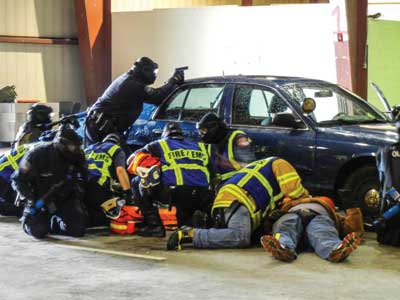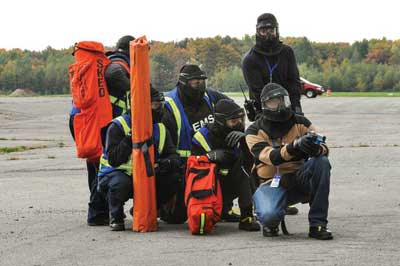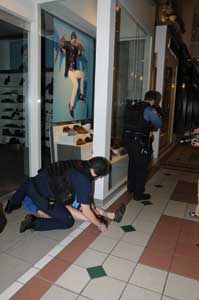BY TRACY L. FRAZZANO and G. Matthew SNYDER
The rapid transition from offense to defense is one that professional athletes master early in their careers. An interception or a sudden change in ball possession results in an immediate and forceful effort to limit the damage from the change in momentum. The reaction on the part of the athlete is nearly instantaneous. This rapid transition concept has applicability for public safety responses to active shooter events. Police, fire, and emergency medical services (EMS) professionals must recognize the change from a dynamic situation (one that is evolving rapidly because of a suspect’s actions) to a static one (one that is contained). Once realizing the change, they must instinctively shift their collective priorities from neutralizing a threat to saving the lives of victims and potential casualties.
 |
| (1) Law Enforcement and EMS coordinated response to multiple casualties while under fire. (Photos 1-4 courtesy of the New York State Division of Homeland Security & Emergency Services/National Center of Security & Preparedness.) |
Priority of life is a concept designed to rank the intrinsic value of human life in certain situations against tactical responses. Used by the National Tactical Officers Association (NTOA) to guide operations involving Special Weapons and Tactics (SWAT) teams, the philosophy of life priority during targeted violence incidents is relevant for all public safety disciplines.1 Once the threat level changes from dynamic to static, all personnel capable of saving lives must agree to prioritize their triage efforts as follows: innocent victims, first responders, and then finally suspects. This transition has been a challenge for public safety professionals to embrace and apply in part because of parochial limitations in unified response training and tactics.
Law enforcement professionals from agencies of all sizes and missions agree that stopping the killing is priority one when faced with active deadly violence. The second priority of stopping the dying has to be committed to and acted on to limit the lethality of an attacker. 2Active Shooter Events and Response analyzed active shooter events and the lessons learned from them over the past decade. Their research underscores the difficulty first responders often have in transitioning from neutralizing the threat to saving lives. The cost of this delay can often be counted in lives lost. The benefit of rapid medical attention in an area in which a threat is still present (warm zone) can be measured in lives saved. As seen in the Boston Marathon, with medical personnel stationed not far from the finish line (and site of the bomb detonation), medical attention to the bombing victims was almost immediate. Regrettably, three lives were lost; however, more than 200 others who were injured survived, including dozens who had limbs amputated.3
 |
| (2) Law enforcement tactical escort of EMS into a warm zone. |
EMPHASIS ON PREHOSPITAL CARE
Fortunately, new doctrine does not have to be developed and new research does not have to be commissioned to support a refinement in the “offense to defense” transition first responders make after a threat has been neutralized. Collective training across disciplines is required to ensure tactical and medical skills are maintained by all personnel who may be dispatched to a mass-shooting event. Model protocols are available to break the linear response cycle that has one public safety discipline waiting while another is working.
Respected educational institutions such as the National Center for Security & Preparedness at the State University of New York-Albany and the Advanced Law Enforcement Rapid Response Training Center at Texas State University have developed tactically and operationally sound protocols worth consideration by public safety professionals. These protocols strive to resolve the universal goal of achieving the strongest offense and strongest defense among public safety professionals responding to active shooter and hybrid targeted violence events (HTV).4 Working together in warm zones to provide casualty care, casualty collection, and casualty extraction is a core learning objective for these programs. This can only be achieved when first responders are conditioned to work together.
 |
| (3) Law enforcement learning the techniques of Tactical Emergency Casualty Care. |
TACTICAL COMBAT CASUALTY CARE
In 1996, the United States military introduced the concept of Tactical Combat Casualty Care (TCCC). This prehospital care protocol was based on Captain Frank Butler and Lieutenant Colonel John Hagmann’s study of combat-related deaths. The paradigm shifting research found that 90 percent of combat deaths occurred before a casualty reached a medical facility.5 Limitations identified in advanced trauma life support for combat medics led the military to develop a new set of principles for high-threat trauma care. The TCCC guidelines influenced a shift to address preventable causes of combat death by optimizing care rendered in the field prior to arrival at a fixed medical facility. In essence, every soldier had to have trauma care capabilities.
Over the years, TCCC guidelines have shown to be extraordinarily effective in combat environments. The success of TCCC led to the development of a civilian counterpart of the protocol known as Tactical Emergency Casualty Care (TECC).6 TECC provides a tactically and medically sound framework to deliver direct threat care, indirect threat care, and evacuation of casualties in a manner that optimizes the preservation of life. These protocols include the incorporation of the fire and EMS communities in operations that are ongoing and high-risk. The principal mandate of TECC is prioritizing medical intervention at these critical times in the same manner as TCCC protocols treat combat wounds at the point of injury. Recent events such as the mass shootings in Aurora, Colorado, and Newtown, Connecticut, and the bombing at the Boston Marathon have demonstrated the need for skilled prehospital trauma care.
 |
| (4) Law Enforcement and EMS learning the techniques of a coordinated response. |
The American College of Surgeons, in the Hartford Consensus, compelled first responders to adopt integrated response procedures to achieve rapid hemorrhage control, rapid extraction to safety, and transport to definitive care to limit deaths from mass-casualty shooting events.7 The council of medical experts insisted that hemorrhage control be a core law enforcement capability. The report emphasized this point by stating: “Maximizing survival requires an updated and integrated system that can achieve multiple objectives simultaneously.” To realize the objectives of the Hartford Consensus, first responders must share tactical and emergency medical skills across disciplinary lines. Considerable knowledge on casualty care can be transferred from the EMS community to law enforcement. Conversely, substantial knowledge on reacting to an ambush, using contact and cover principles, and incendiary explosive device identification can be transferred from law enforcement to EMS. First responders collectively applying these unconventional skills through tabletop exercises, drills, and full-scale exercises will ensure they are working in harmony when called on to save lives in an actual crisis.
Over a decade of warfighting has taught the military that a hastily applied tourniquet or pressure dressing means the difference between life and death. During the same period, an analysis of active shooter events and mass-casualty shootings has underscored the importance of transitioning from threat neutralization to rapid medical intervention. Since the Columbine High School HTV attack in 1999, law enforcement agencies across the country adopted immediate response protocols to neutralize active shooters. A similar universal appreciation for cooperative police, fire, and EMS warm zone casualty care must be perfected. Law enforcement officers must also appreciate their role in providing casualty care to trauma victims. Those victims may be civilians, or they may be first responders. In some cases, law enforcement officers may be treating themselves after a traumatic injury.
 |
| (5) A rescue task force medic provides casualty care in the warm zone with law enforcement protection during an active shooter exercise. [Photo courtesy of Dr. Reed Smith of the Arlington County (VA) Fire Department.] |
Through training and exercises, roles and responsibilities must be refined prior to a critical event. This is especially true with casualty care. As a result of the increase of high-priority HTV incidents like the Boston Marathon, the Federal Emergency Management Agency now recommends that paramedics enter these active situations expeditiously.8 HTV events are requiring local jurisdictions to build resources well beyond the traditional training and experience of the majority of our first responder community. The United States military has learned in the last decade of war fighting that care under fire and combat casualty care skills must also be held by those who hold the weapons. These skills should not be held in reserve until a safe crime scene is established.
In sports, the transition from offense to defense, and vice versa, can determine the winner of the game. Although active shooter events and incidents of mass casualties should never be viewed as a “game,” the role of first responders in the ultimate success or failure of such an event should never be underestimated. Sacrifices made by our armed forces through the loss of life and limb have yielded casualty care protocols that would be a travesty to ignore to protect the homeland. Adopting these protocols, mastering the transition from offense to defense, and achieving a one team-one fight approach is a game-changing perspective that will always play in favor of the winning team.
Endnotes
1. National Tactical Officers Association. SWAT Standards for Law Enforcement, 2011, retrieved from ntoa.org/site/images/stories/swatstandards.pdf.
2. Blair, John P., et al. Active Shooter Events and Response. CRC Press LLC, 2013.
3. Bodden, Valerie. Boston Marathon Bombings. ABDO Publishin g Company, 2014.
4. Hybrid target violence (HTV) is an intentional use of force to cause physical injury or death to a specifically identified population using multifaceted conventional weapons and tactics. Frazzano, T.L. & Snyder, G. M. (2013b) Hybrid Targeted Violence: Fire, Firearms & Complex Threats. DomPrep Journal. 9 (3), p. 5-7.
5. Butler F.K. Jr., Hagmann J. & Butler E.G. Tactical combat casualty care in Special Operations. Military Medicine, 1996:161:p. 3–16.
6. Committee for Tactical Emergency Casualty Care. Executive Summary of the Tactical Emergency Casualty Care (TECC) Guidelines. Retrieved December 8, 2013 from http://c-tecc.org/executive-summary-tecc-guideline.
7. American College of Surgeons, Joint Committee to Create a National Policy to Enhance Survivability from Mass Casualty Shooting Events. Improving Survival from Active Shooter Events: The Hartford Consensus. June 1, 2013. Retrieved from http://bulletin.facs.org/2013/09/.
8. National Fire Academy (September 2013). Fire/EMS Department Operational Considerations and Guide for Active Shooter and Mass Casualty Incidents. Retrieved from http://www.usfa.fema.gov/downloads/pdf/publications/active_shooter_guide.pdf.
TRACY L. FRAZZANO is a lieutenant with the Montclair (NJ) Police Department. She serves as a subject matter expert and instructor for the National Center for Security & Preparedness supporting the New York State Division of Homeland Security and Emergency Services. She was awarded the 2011 Center for Homeland Defense and Security Alumni Fellowship and was detailed to the United States Department of Homeland Security, Federal Emergency Management Agency in Washington, D.C. for one year. A 2010 graduate of the Center at the Naval Postgraduate School in Monterey, California, she earned an MA degree in security studies (homeland security and defense). She also has an MA degree in human resources training and development from Seton Hall University.
G. MATTHEW SNYDER is an advanced leadership instructor with a federal law enforcement agency. He has been employed as a police officer with the Waynesboro (VA) Police Department since 1992. Formerly a full-time patrol officer, he now serves as a part-time investigator assigned to the Criminal Investigations Division. In 2010, he retired from the U.S. Army at the rank of command sergeant major with more than 24 years of active and reserve service. He has a master’s degree in public administration from James Madison University and recently completed all coursework toward a doctorate in education at Liberty University. His ongoing dissertation research is focused on training and education related to hybrid targeted violence.
Fire Engineering Archives

